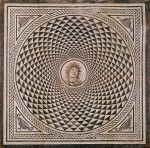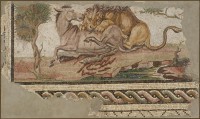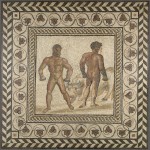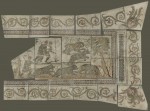 The Getty Museum in Los Angeles has an exceptional collection of Roman floor mosaics from the Imperial era. Some of them have been on display consistently, but others will be seen by the public for the first time in Roman Mosaics Across the Empire, a new exhibition that opened on Wednesday at the Getty Villa. It features mosaics from provinces of the Roman Empire all over the Mediterranean — Italy, France, North Africa, Syria — done in different styles with different themes.
The Getty Museum in Los Angeles has an exceptional collection of Roman floor mosaics from the Imperial era. Some of them have been on display consistently, but others will be seen by the public for the first time in Roman Mosaics Across the Empire, a new exhibition that opened on Wednesday at the Getty Villa. It features mosaics from provinces of the Roman Empire all over the Mediterranean — Italy, France, North Africa, Syria — done in different styles with different themes.
 There’s bear hunt from Baiae, outside of Naples, a head of Medusa surrounded by a glorious optical illusion-inducing geometrical design from Rome, an Orpheus surrounded by animals from Saint-Romain-en-Gal, France, a hare and two birds with geometric border panels from Antioch, Syria, a dramatic lion attacking an onager from Hadrumentum, modern-day Sousse, Tunisia. These are top quality artworks which adorned the homes of the very wealthy, public baths, even early Christian churches.
There’s bear hunt from Baiae, outside of Naples, a head of Medusa surrounded by a glorious optical illusion-inducing geometrical design from Rome, an Orpheus surrounded by animals from Saint-Romain-en-Gal, France, a hare and two birds with geometric border panels from Antioch, Syria, a dramatic lion attacking an onager from Hadrumentum, modern-day Sousse, Tunisia. These are top quality artworks which adorned the homes of the very wealthy, public baths, even early Christian churches.
 The show also features a close look at the Getty Conservation Institute’s work conserving the mosaics from the Imperial Roman heyday of Bulla Regia in Tunisia, North Africa. Known for its unique villas with subterranean floors — smart design in the heat of Tunisia — Bulla Regia had the greatest numbers of senators in Roman North Africa. It was an important city and its exquisite art and architecture testify to that importance. The GCI is working with the Institut National du Patrimoine of Tunisia and the World Monuments Fund to fully conserve one of the most important private residences in the city, the House of the Hunt, and to devise a plan for the long-term conservation and maintenance of the 400 mosaics that have already been unearthed at Bulla Regia over the past hundred years. Some of the works will be restored for display; others will be reburied. The idea is to make Bulla Regia a template for in situ conservation that can be applied to mosaics elsewhere in North Africa, the Middle East and elsewhere in the Mediterranean.
The show also features a close look at the Getty Conservation Institute’s work conserving the mosaics from the Imperial Roman heyday of Bulla Regia in Tunisia, North Africa. Known for its unique villas with subterranean floors — smart design in the heat of Tunisia — Bulla Regia had the greatest numbers of senators in Roman North Africa. It was an important city and its exquisite art and architecture testify to that importance. The GCI is working with the Institut National du Patrimoine of Tunisia and the World Monuments Fund to fully conserve one of the most important private residences in the city, the House of the Hunt, and to devise a plan for the long-term conservation and maintenance of the 400 mosaics that have already been unearthed at Bulla Regia over the past hundred years. Some of the works will be restored for display; others will be reburied. The idea is to make Bulla Regia a template for in situ conservation that can be applied to mosaics elsewhere in North Africa, the Middle East and elsewhere in the Mediterranean.
Highlights of the site’s breathtaking beauty can be seen in this video about the project:
[youtube=https://youtu.be/LedaeWnjudE&w=430]
The focus on best practices of situ conservation is in marked contrast to the Getty’s past see-no-evil acquisition policy evinced in more than one of the mosaics on display in this exhibition. The Getty bought 23 panels of the Bear Hunt in 1972 from a Switzerland-based antiques dealer (surprise!) who told  them only that it had been in an Italian collection. It was almost certainly illegally exported, but the museum looked the other way as it so often did. Recently Getty researchers attempted to trace the ownership history and there’s a big gap between 1929 and 1972. The last known owner in 1929 was refused an export license because there were doubts as to whether he actually had legal title to the mosaic. Somewhere in those four decades, probably closer to 1972 than 1929, the mosaic was trafficked to Zurich and thence to the Getty. Four other panels from the original mosaic were eventually found by the Italian police and are now in the Museo Archeologico Nazionale in Naples.
them only that it had been in an Italian collection. It was almost certainly illegally exported, but the museum looked the other way as it so often did. Recently Getty researchers attempted to trace the ownership history and there’s a big gap between 1929 and 1972. The last known owner in 1929 was refused an export license because there were doubts as to whether he actually had legal title to the mosaic. Somewhere in those four decades, probably closer to 1972 than 1929, the mosaic was trafficked to Zurich and thence to the Getty. Four other panels from the original mosaic were eventually found by the Italian police and are now in the Museo Archeologico Nazionale in Naples.
The Getty is offering a number of lectures related to the exhibition. The Handling Session looks particularly compelling.
How were mosaics created from pieces of stone and glass? Learn how these intricate architectural decorations were made in this multisensory handling session. Touch tools and materials similar to those used by ancient mosaicists, including tesserae, slaked lime, marble dust, and nippers.
Lucky Angelenos can take an early lunch and handle tesserae every Thursday and Friday from 11:00 AM-12:00 PM through September 9th. The exhibition runs until September 12th, 2016. For those of us who won’t be able to see the mosaics live, the Getty has made a companion catalogue to the exhibition available free online: Roman Mosaics in the J. Paul Getty Museum.

Very interesting vid and the mosaics are beautiful!
I could look at mosaic pictures all day and all night, I swear.